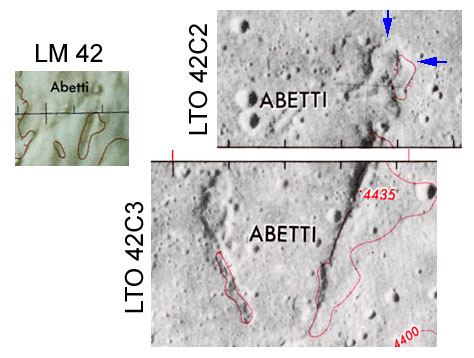Abetti
Contents
Abetti
|
Lat: 20.11°N, Long: 27.82°E, Diam: 1.6 km, Depth: km, Rükl: 24 |

LM-42; LTO 42C2; and LTO 42C3 The small blip at the blue arrows seems the most likely identification of this feature based on the diameter of 1.5 km given in the on-line IAU Planetary Gazetteer (citing LM-42 as the map reference), although it seems to be the larger feature on LTO 42C3 that was actually approved by the IAU General Assembly in 1976.
Images
LPOD Photo Gallery Lunar Orbiter Images Apollo Images
- Apollo 17's orbital Hasselblad photograph AS17-150-23013 shows the formation officially known as Abetti near the frame's left margin (south at top, north at bottom).
- Abetti was also captured on Apollo 17's orbital ITEK-panoramic frames AS17-P-2317 and AS17-P-2322. In both frames, Abetti is visible "about halfway".
- Additional research Apollo photographs: Danny Caes
Maps
(LAC zone 42C2) LAC map Geologic map LM map LTO map (42C2: northern part of Abetti), LTO map (42C3: southern part of Abetti)
Description
Wikipedia
Abetti (Note: the Wikipedia describes this as a "ghost crater", probably referring to the two ridges in Rükl and LTO 42C3)
Additional Information
- IAU page: Abetti
Nomenclature
- Named for Antonio Abetti (1846-1928) and Giorgio Abetti (1882-1982), Italian astronomers. Both members of this father and son team of astronomers were very well known in their day, and both served long terms as director of the Arcetri Observatory in Florence. Giorgio was not only a Vice President of the IAU, but a great popularizer of astronomy with many widely-read books. The nearly invisible crater (?) named after them hardly seems an appropriate memorial.- Jim Mosher
- The name Abetti (honoring Antonio) was approved for a feature at 19.8°N, 27.7°E "as now assigned and printed on the 1:250,000 lunar map series" (LTO's) in 1976 (IAU Transactions XVIB). Giorgio was approved "as assigned" for the feature at 19.9°N 27.7°E (presumably as a co-honoree) in 1985 (IAU Transactions XIXB).
- The current intended identity of this IAU-named feature is something of a mystery. Rükl (on his Map 24) suggests the name refers to the ~6 km wide region between two low ridges in Mare Serenitatis at approximately 19.8 N/27.7 E, a notion he probably got from the IAU's 1976 approval of a feature at that location, presumably as represented on LTO 42C3, where it is so labeled. However, the current IAU coordinates (given in the title line of this page, but of unknown origin) indicate that the intended feature is now more likely a 1.5 km diameter crater located about 6.5 km to the NE of this position. Moreover, the on-line IAU Planetary Gazetteer indicates that the correct map to use for identification is LM-42 where a distinct crater of approximately the right size is depicted beyond the north end of the eastern ridge. So the label on LTO 42C3 appears to be in error; but the problem is there is no photo showing a clear crater at the current IAU location. The area is plotted in more detail on LTO 42C2, but the placement of the "Abetti" label on that map leaves the identification of the intended feature quite ambiguous. If LM-42 is taken as a guide, the IAU feature is the little dimple in the scab-land indicated by the blue arrows in this detail of LTO 42C2. Whether this is truly a crater or just a minor undulation in the topography is unclear. The Apollo 17 image used for the background (on which the contours are plotted) shows the arrowed feature being mirrored by a similar-sized, and essentially identical, configuration to its west. The two Lunar Orbiter photos on which this region was imaged (LO-IV-078 and LO-IV-075) are even less informative.
- Assuming the location indicated on LM-42 is correct, it seems a bit ironic for the IAU to have honored not just one, but two of its more illustrious members with a 1.5-km dimple so elusive that not even Rükl was able to find it. - Jim Mosher
LPOD Articles
Bibliography
Named Features -- Prev: Abenezra -- Next: Abul Wáfa